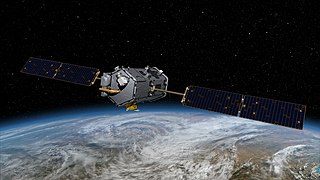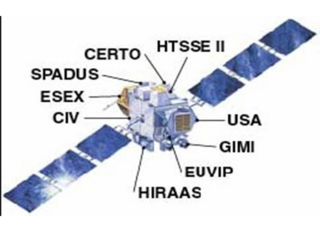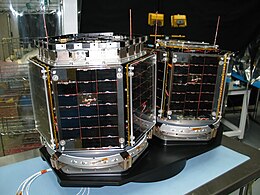
The Air Force Research Laboratory (AFRL) is a scientific research organization operated by the United States Air Force Materiel Command dedicated to leading the discovery, development, and integration of aerospace warfighting technologies, planning and executing the Air Force science and technology program, and providing warfighting capabilities to United States air, space, and cyberspace forces. It controls the entire Air Force science and technology research budget which was $2.4 billion in 2006.

A small satellite, miniaturized satellite, or smallsat is a satellite of low mass and size, usually under 1,200 kg (2,600 lb). While all such satellites can be referred to as "small", different classifications are used to categorize them based on mass. Satellites can be built small to reduce the large economic cost of launch vehicles and the costs associated with construction. Miniature satellites, especially in large numbers, may be more useful than fewer, larger ones for some purposes – for example, gathering of scientific data and radio relay. Technical challenges in the construction of small satellites may include the lack of sufficient power storage or of room for a propulsion system.

United Launch Alliance (ULA), legally United Launch Alliance, LLC, is an American spacecraft launch service provider that manufactures and operates a number of rocket vehicles that are capable of launching spacecraft into orbits around Earth and to other bodies in the Solar System. The company, which is a joint venture between Lockheed Martin Space and Boeing Defense, Space & Security, was formed in December 2006. Launch customers of the United Launch Alliance include the Department of Defense (DoD), NASA, and other organizations.

The Orbiting Carbon Observatory (OCO) is a NASA satellite mission intended to provide global space-based observations of atmospheric carbon dioxide. The original spacecraft was lost in a launch failure on 24 February 2009, when the payload fairing of the Taurus rocket which was carrying it failed to separate during ascent. The added mass of the fairing prevented the satellite from reaching orbit. It subsequently re-entered the atmosphere and crashed into the Indian Ocean near Antarctica. The replacement satellite, Orbiting Carbon Observatory-2, was launched 2 July 2014 aboard a Delta II rocket. The Orbiting Carbon Observatory-3, a stand-alone payload built from the spare OCO-2 flight instrument, was installed on the International Space Station's Kibō Exposed Facility in May 2019.

The Advanced Research and Global Observation Satellite (ARGOS) was launched on 23 February 1999 carrying nine payloads for research and development missions by nine separate researchers. The mission terminated on 31 July 2003.
The University Nanosat Program is a satellite design and fabrication competition for universities. It is jointly administered by the Air Force Office of Scientific Research (AFOSR), the Air Force Research Laboratory (AFRL), the American Institute of Aeronautics and Astronautics (AIAA), the Space Development and Test Wing and the AFRL Space Vehicles Directorate's Spacecraft Technology division. NASA's Goddard Space Flight Center was involved from the program inception through Nanosat-3.

The Boeing CST-100Starliner is a class of two partially reusable spacecraft designed to transport crew to the International Space Station (ISS) and other low-Earth-orbit destinations. It is manufactured by Boeing for its participation in NASA's Commercial Crew Program (CCP). The spacecraft consists of a reusable crew capsule and an expendable service module.

Radio Aurora Explorer (RAX) is the first National Science Foundation sponsored CubeSat mission. The RAX mission is a joint effort between SRI International in Menlo Park, California and the University of Michigan in Ann Arbor, Michigan. The chief scientist at SRI International, Dr. Hasan Bahcivan, led his team at SRI to develop the payload while the chief engineer, Dr. James Cutler, led a team of students to develop the satellite bus in the Michigan Exploration Laboratory. There are currently two satellites in the RAX mission.

Ralphie was a satellite, part of the Three Corner Satellite (3CS) project, a three satellite student research project. It was designed and built by mostly undergraduate students at the University of Colorado Boulder as part of the Air Force Research Laboratory's University Nanosat Program.

Sparkie was a satellite, part of the Three Corner Satellite (3CS) project, a three satellite student research project. It was designed and built by mostly undergraduate students at the Arizona State University as part of the Air Force Research Laboratory's University Nanosat Program.

Petey was a satellite, part of Three Corner Satellite (3CS) project, a three satellite student research project. It was designed and built by mostly undergraduate students at the New Mexico State University as part of the Air Force Research Laboratory's University Nanosat Program. It was responsible for communication system in 3CS project.

A number of space tethers have been deployed in space missions. Tether satellites can be used for various purposes including research into tether propulsion, tidal stabilisation and orbital plasma dynamics.
Hermes was an American satellite which was to have been operated by the Colorado Space Grant Consortium. Intended to perform technology demonstration experiments in low Earth orbit, it was lost during launch in March 2011 when the rocket that was carrying it failed to achieve orbit.

Orbiting Carbon Observatory-2 (OCO-2) is an American environmental science satellite which launched on 2 July 2014. A NASA mission, it is a replacement for the Orbiting Carbon Observatory which was lost in a launch failure in 2009. It is the second successful high-precision CO2 observing satellite, after GOSAT.

LunIR is a planned nanosatellite spacecraft that will fly by the Moon and collect surface spectroscopy and thermography. It is planned to fly as a secondary payload on the Artemis 1 mission in 2022.

Psyche is a planned orbiter mission that will explore the origin of planetary cores by studying the metallic asteroid of the same name. Lindy Elkins-Tanton of Arizona State University is the principal investigator who proposed this mission for NASA's Discovery Program. NASA's Jet Propulsion Laboratory (JPL) will manage the project.

ArgoMoon is a cubesat that will launch into a heliocentric orbit on Artemis 1, the maiden flight of the Space Launch System. The objective of the ArgoMoon spacecraft is to take detailed images of the Interim Cryogenic Propulsion Stage following Orion separation, an operation that will demonstrate the ability of a cubesat to conduct precise proximity maneuvers in deep space.

CAPSTONE is a lunar orbiter that will test and verify the calculated orbital stability planned for the Lunar Gateway space station. The spacecraft is a 12-unit CubeSat that will also test a navigation system that will measure its position relative to NASA's Lunar Reconnaissance Orbiter (LRO) without relying on ground stations. It was launched on 28 June 2022, and will spend over six months flying around the Moon.















